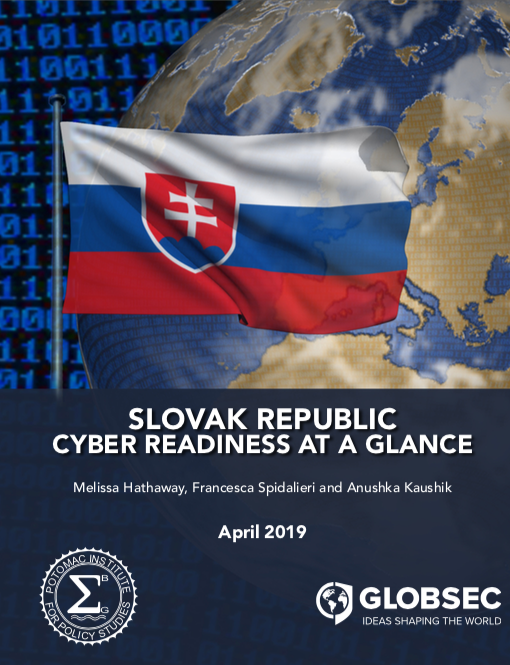GLOBSEC and Potomac Institute for Policy Studies release Cyber Readiness Index 2.0 Assessment for Slovakia

GLOBSEC has partnered with the Cyber Readiness Index 2.0 (CRI) team at the Potomac Institute for Policy Studies (PIPS) – a Washington D.C.-based think tank – and is pleased to announce the release of the "Slovak Republic Cyber Readiness at a Glance." This report provides the most in-depth analysis to date of Slovakia’s current cybersecurity posture and its efforts to strengthen the country's security and resilience in the face of emerging ICT threats.
This joint project marks the first time that the CRI 2.0 methodology has been applied to a Central and Eastern European country. Melissa Hathaway, the CRI leading author, stated: “We are glad to have had such an important partner as GLOBSEC in this region to develop a Cyber Readiness Index profile for Slovakia. This was an important evaluation to undertake because Slovakia is a strategic member of the EU, NATO, and the Visegrád Group alliances, and has a critical location in Central-Eastern Europe. As the first profile in the Visegrád Group, we hope it will pave the way for more countries in the region to understand the value of such an analysis.”
Robert Vass, President & Founder of GLOBSEC, stated: “We’re very pleased to have partnered with the CRI team at the Potomac Institute on this project. For Slovakia, cybersecurity must be a priority and this is the most comprehensive cyber readiness mapping exercise done in the country to date. It has been GLOBSEC’s aim since its inception to provide a better understanding of global security threats and their consequences for society and governance. The CRI 2.0 country profile for Slovakia does just that.”
"Modern technologies introduced many benefits, but also made us depended on the information and communication technologies and infrastructure (ICT). ICT infrastructure is open and fragile. It can be compromised with a limited budget. Its security requires well-prepared politics, processes and technology. That creates asymmetry which has to be understood and accepted. To protect our way of life, we all have to work together: general public, education system, industry and the government," said Peter Dostál, managing director, CEO Aliter Technologies, a.s.
According to the CRI 2.0 assessment, Slovakia is still in the early stages of developing a path toward cyber resilience and cyber readiness. The Slovak government launched important political and economic reforms to accelerate Slovakia’s development, connectivity, and digital economic growth in the early 2000s and recognized the need to become cyber ready as early as 2008. The call to action from NATO and the EU to address the national security and economic risks of cyber insecurity has further sharpened Slovakia’s focus toward cyber defence. The challenge, however, is that these two sets of goals – digital growth and national cybersecurity – are still being executed by separate entities. The digitization of the country and the digital economic priorities (aligning Slovakia to the EU Single Digital Market) are being led by the Office of the Deputy Prime Minister for Investments and Informatization. Whereas the cyber resilience and cyber defence priorities of the country are being led by the National Security Authority (NBU). Slovakia needs to better align its initiatives to meet the expectations of the international institutions and its business community, and champion the cybersecurity and resilience considerations as part of the country’s overall planning process.
The CRI 2.0 report for Slovakia identifies areas where policymakers can alter or refine the country’s current posture by leveraging or updating laws, policies, standards, market levers, etc., and implementing other initiatives to preserve the security of their connectivity and protect the value of their economy. Slovakia economically desires to reach the same growth level as countries such as Finland, Sweden, and Estonia, where the digital economy already accounts for 5 to 5.5% of their GDP. The NBU has a critical role in enhancing the country’s cyber posture strategically. As the national competent authority for cybersecurity, it has the opportunity to frame the national narrative and articulate why a whole-of-government approach is needed to reduce economic and societal risk. Establishing clear lines of accountability and responsibility, and successfully achieving each milestone set forth in their strategies will allow Slovakia to establish credibility and foster confidence in the country’s ability to ensure its future safety, security, and economic wellbeing.
The CRI 2.0 uses over seventy unique indicators across seven essential elements to discern operationally ready activities and identify areas for improvement in the following categories: national strategy, incident response, e-crime and law enforcement, information sharing, investment in research and development, diplomacy and trade, and defence and crisis response. The CRI 2.0 methodology is the only methodology publicly available in all six United Nations languages (Arabic, Chinese, English, French, Russian, and Spanish), and it is being applied to countries around the world. In-depth assessments have been completed on France, Germany, India, Italy, Japan, the Kingdom of Morocco, the Netherlands, the Kingdom of Saudi Arabia, Singapore, Slovak Republic, South Africa, the United Kingdom, and the United States.
